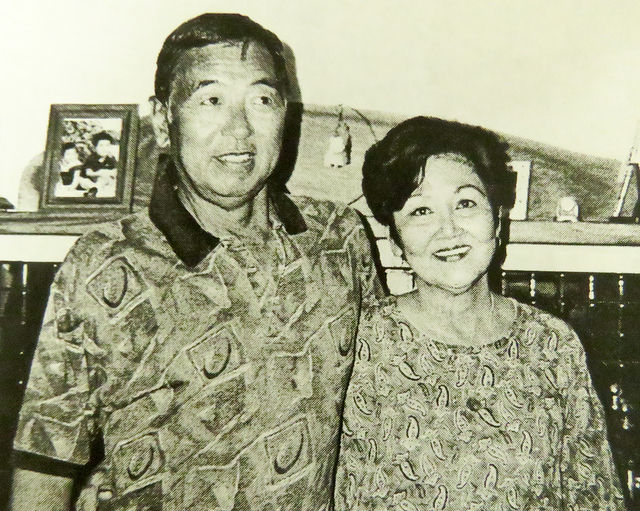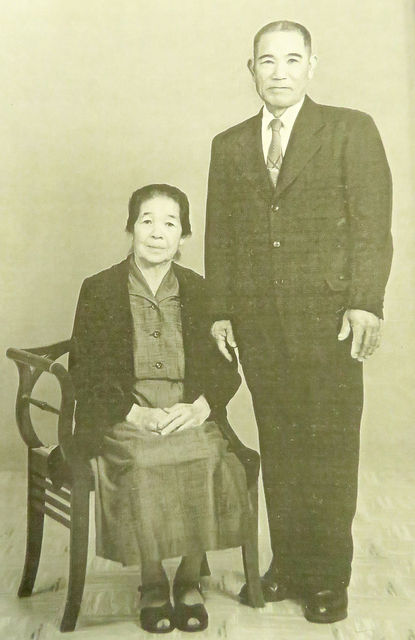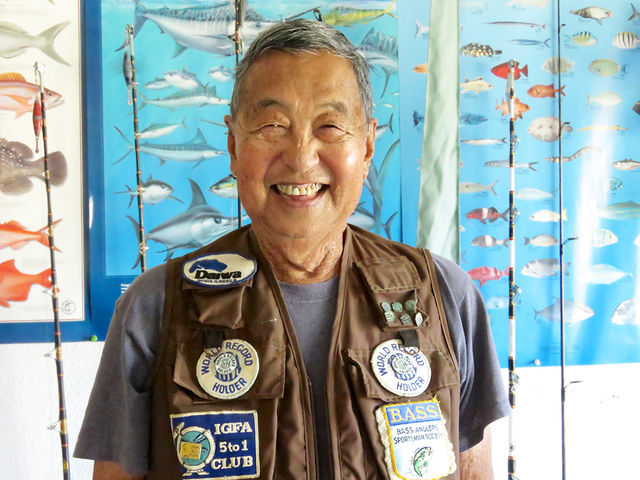From sugar to guavas, via Iraq and Iran
When Norio “Jack” Gushiken began working for Kilauea Sugar Plantation on the island of Kauai at the age of 18, he never imagined that his job as a field hand that paid $6.36 per day would evolve into a career in agricultural management that has spanned six decades, allowed him to travel the world, and even gave him the opportunity to develop his own variety of guava.
Now 76 years old, Jack looks back with his characteristic sense of humor and understated pride at how far he came since the days of attending elementary school barefoot, as did all the children in those years.
Gushiken family history in Hawaii began when Jack’s grandfather emigrated from Okinawa to work in the sugar fields in 1909. When Jack turned 18 and needed work, it felt natural for him to turn to the same sugar plantation that employed both his grandfather and father.
But Jack’s career with Kilauea Sugar hit a speed bump almost as soon as it began.
“After one month of working, the sugar industry went on a four-month strike,” he says.
Fortunately his wife, Aiko, also known as Aik, had a job working at a local store so she was able to support the household that included their several-week-old daughter.
After the strike ended, sugar plantation life was good for the young family. The plantation provided them a home for which rent was $12 per month. Electricity was provided at no cost — but whenever the power generation unit at the sugar mill broke down, their household had no lights.
Baghdad, Iraq, where is that?
Over time, Jack became irrigation supervisor and was responsible for 1,200 acres of sugar cane. But after he had worked there for 14 years, C. Brewer & Co. shut Kilauea Plantation’s doors in 1971.
Feeling like there were few other viable employment options on Kauai, Jack was interested in, C. Brewer offered him a job in Iraq, teaching the residents how to grow sugar cane.
But he was also puzzled.
“When they mentioned Baghdad, Iraq, we couldn’t figure out where is that? Even the travel agency, they didn’t know where it was, this Baghdad, Iraq,” Jack says, laughing at the memory.
The journey to Iraq was Jack’s first trip outside of Hawaii, and it was eventful — especially when he got to New York and found out he would be traveling the rest of the way on Iraq Air, complete with passengers seated in the aisles.
After overcoming his initial shock at desert temperatures that hovered around 120, dust everywhere and no green plants or mountains, Jack found himself in his element, supervising local Iraqis and showing them the basics of growing cane. Communication was challenging, with much of it accomplished via translator and a Hawaiian-Arabic version of Pidgin English.
After about six months, Saddam Hussein came into power and kicked Americans out of the country. Jack flew home via the Orient, touring India, Nepal, Pakistan, Thailand, Hong Kong, Okinawa and Guam. While in Okinawa, he visited his grandfather, who had by then returned home and made wise investments in Okinawa using his sugar plantation earnings.
“Today, I still cannot figure out how actually they saved money while making only 50 cents a day,” Jack says, marveling at his grandparents.
From camels to tractors
After a couple years back on Kauai, working for Olokele Sugar on Kauai’s west side, Jack was given another opportunity to go overseas. This time C. Brewer asked him to go to a 20,000-acre project site in Iran and teach the locals how to grow sugar beets, wheat, cotton, alfalfa, and also how to raise sheep and cattle that had been imported from the United States.
Jack’s project site was 700 miles from the capital city of Tehran, where Aik and the couple’s three children attended school. Aik figured out how to navigate the foreign city on her own.
“Aik learned how to walk the dirty streets, avoid the beggars, and she found food that we could eat,” Jack says. “My wife made her own bread and saimin. Good thing we brought our own shoyu.”
One day while shopping in a bazaar (open-air marketplace), Aik spotted an ulua (trevally).
“She couldn’t believe her eyes,” Jack says. “How could an ulua get to the market so many miles away from the ocean?” Having grown up on Kauai around lots of fresh fish, Aik knew how to inspect the fish eyes and gills to be sure it was fresh. “She hand-carried that fish home wrapped in dirty newspaper, its tail flapping in her face the whole way,” Jack says. “That fish tasted ono!”
During Jack’s travels between Tehran and his project site, “all I could see was miles and miles of sand, no trees and no mountains,” he says. “I saw thousands of sheep, and a lot of camels in the dust.”
Teaching 4,000 Iranians the finer points of agriculture and livestock rearing was challenging. “Can you imagine training a person whose family has been riding camels for 5,000 years how to operate a tractor in one month?”
There were also greater socio-political differences to overcome.
“We were working with a socialist-type government,” Jack says. “You had to be really careful what you said, because if you told the wrong person that an employee did something wrong, they disappeared the next day.”
Some employees tried convincing Jack to give them raises or better jobs, using inducements with which they were familiar. “A lot of the village people offered me their wives, with sheep,” he says, chuckling. “A little higher class people, they used to bring camels.”
The Gushiken family lived in Iran for about six years, during which time Jack took great pleasure exploring ruins of ancient civilizations, imagining how people lived in that region thousands of years ago. He often came across nearly indestructible remnants of homes while clearing fields with his tractor.
“The old, old houses, built in 2,000 or 3,000 BC, our tractors couldn’t knock them down,” he says. “They were so solid, built with bricks of straw and clay.”
From their headquarters in Iran, the family was also able to visit 40 countries.
“Working in Iraq was good for us,” he says. “But all the good things came to an end with the Islamic Revolution” in 1979, when the family returned home to Kauai.
Home sweet home
As his time in Iran was coming to a close, C. Brewer once again came up with a good offer. This time, the CEO said he would give Jack only two seconds to decide whether or not to take this new job.
“We’ve got an opening in Kilauea,” the man told Jack. “We are going to grow guavas and begin an aquaculture operation growing fresh-water prawns.”
Jack needed only one second to decide. “I said I want to go back home!”
This began a 30-year chapter in Jack’s already distinguished career at Kilauea Agronomics’ Guava Kai Plantation. He designed and supervised the planting of a 500-acre guava orchard, planting the rows of trees facing from north to south to maximize the amount of sunlight they absorbed, a technique he learned from similarly-planted orchards in California.
While the guava trees were growing, construction began on the prawn ponds. “By the end of the year we installed 30 ponds, or 100 acres of water,” Jack says. They were able to bring the prawns through their full life cycle, from the hatchery, to nursery to the grow-out ponds, where the prawns where harvested for sale to local markets.
“Of all the agricultural crops that I’ve grown, raising prawns was the most complex. They needed supervising around the clock, night and day,” he says. “When we first started, we thought with maybe three pounds of feed, we could produce a pound of prawns. But because of the water temperature, it became something like 8-to-1.”
They tried increasing protein levels in the prawns’ feed, but the cost was too great. In two years, they shut down the prawn operation. Some years later, the man-made ponds were filled with dirt and leveled.
But the guavas were thriving, and Jack was in his element. When juice giant Ocean Spray made the seemingly-impossible request for the harvest time of year to be changed from September to March, Jack made it happen.
He even created his own variety of guava, named the Gushiken Sweet, distinguished by its high nutrient value. “And of course it tastes better!”
Full Circle
In an interesting twist of fate, in his pseudo-retirement, Jack now travels to Micronesia and other locales, recruiting workers for agricultural jobs in Hawaii, just as his grandfather was lured to Kauai to work in the sugar fields 106 years ago.
He is also an avid fisherman who has fished all over the world, holds various world records and is included in the “Freshwater Fishing Hall of Fame & Museum” book. In fact, a C. Brewer newsletter article once described him as “a fishing addict: If he doesn’t go fishing three or four times a week, he gets withdrawal symptoms.”
As he reflects back on his accomplishments, Jack says the one person who made all of them possible is his wife, Aik, to whom he has been married for 58 years. “You can be a success when you have a good team.”
•••
Pamela Varma Brown is a writer and the founder of Write Path Publishing. Sign up to receive her stories in your email inbox: visit www.writepath.net




